



Meet The Whales! Many species are commonly found off our coast!
There are at least 85 different species of the order cetaceans: whales, dolphins and porpoises. They are divided into two sub-orders: baleen and toothed whales. Baleen whales include the humpback, blue, fin, and minke whales. These animals have two blowhole openings on top of their head and have baleen plates hanging from their upper jaw. These baleen plates help whales filter lots of small fish and plankton out of the water. Toothed whales include the sperm whale, beaked whales and all the dolphin and porpoises. These animals have a single blowhole opening and between 2-112 teeth in their mouth. They use their teeth to capture one bigger fish, squid or other marine mammal (in the case of the orca). Below is a list of species that we see off our coast. The first group listed, we commonly encounter, and the others are seen only occasionally.
HUMPBACK WHALE
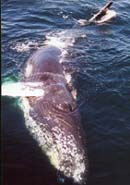
Megaptera novaengliae
From the Greek megas, for “large”, pteron, for “wing” or “fin”.
Length: Adults 45-55 ft; Males, 49 ft, Females, 53 ft.
Weight: Adults weigh between 25 and 40 tons
At Birth: Length 14 ft. and weight about 2 tons
FIN WHALE
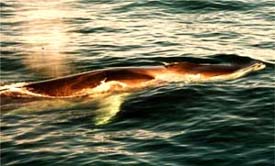
Balaenoptera physalus
From the Greek physalos for “rorqual whale” or “toad that puffs itself up”
Length: 88 ft. in the Southern Hemisphere and 79 ft. in the Northern Hemisphere
The females are usually larger than males.
Weight:Up to 70 tons, 2nd in size only to the blue whale.
At Birth: A calf is 20 ft. long at birth and weighs 1.9 tons
MINKE WHALE
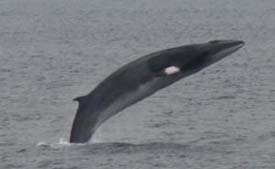
Balaenoptera acutorostrata
From the Latin acutus for “sharp, pointed”, and rostram for “beak, snout”.
Length: 36 ft. in the Northern Hemisphere and 30 ft. in the
Southern Hemisphere.
The females are larger than males.
Weight: 4-5 tons at sexual maturity
At Birth: 8.5 ft. long
ATLANTIC WHITE-SIDED DOLPHIN
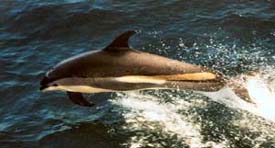
Lagenorhynchus acutus
Lags is short for Lagenorhynchus and the Latin name acutus means “sharp” or “pointed”Length: More than 8 feet long; Males are larger than females.
Weight: Females are 400 lbs, whereas, males are about 510 lbs.
At Birth: Calves are about 4 feet long and weigh around 44 lbs.
NORTHERN RIGHT WHALE
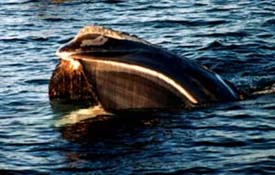
Eubalaena glacialis
From the Greek eu for “right” or “true” and the from the Latin balaena for “whale”; the Latin glacialis for “icy” or “frozen”Length 45-50’ (17 m)
Males are 3-5’ (1-1.5 m) shorter than females
Weight Up to 100 tons or 200,000 lb (90,000 kg)
At birth: 13-15 ft. long (4-4.6 m) and weigh 2000 lbs (910 kg)
HARBOR PORPOISE
Phocoena phocoena
Length: Maximum length is 6 ft. (1.9 m) Most smaller than 5 ft.
Weight: Maximum weight of 200 pounds (90 kg). Most weigh less than 130 pounds (60 kg). The females are slightly larger than the males.
At birth: Calves are 27 to 35 inches at birth (70 to 90 cm) and weigh 14 to 22 pounds (6.4 to 10 kg)
These species have been occasionally found off our coast.
SEI WHALE
Balaenoptera borealis
From the Norwegian name for Pollock, seje, a close relative of codfish. Sei whales appeared off the coast of Norway at the same time each year as the pollock that came to feed on the abundant plankton.
Length: 13.7 to 16.8 meters (45 to 55 feet) Weight: 14 to 17 tons
At birth: 4.3 to 4.6 meters (14 to 15 feet), ~2000 pounds
BLUE WHALE
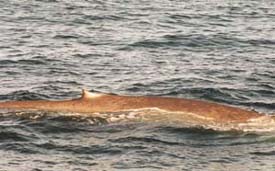
Balaenoptera musculus
From the Latin balaena for “whale” and the Greek pteron for “wing” or “fin” from the Latin musculus, siminutive of mus for “mouse”, although more likely, “muscle”
Length: 85 ft. in the Northern Hemisphere and 100 ft. in the
Southern Hemisphere
Females are larger than males.
Weight: Reaches a weight of over 160 tons and possibly as much as 196 tons.
At Birth: 23 ft. long and weighs 2.5 tons
SPERM WHALE
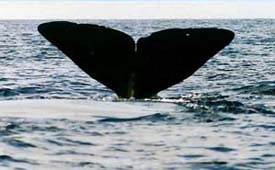
Physeter macrocephalus
Literally translates to "blower with a big head".
Length: Males can reach up to 60 ft. and females about 40 ft. Weight: Males reach 125,000 lbs, while females are about half that (62,000 lbs.)
At birth: 13 ft. long and weighs about 1 ton or 2000 lbs.
LONG FINNED PILOT WHALE
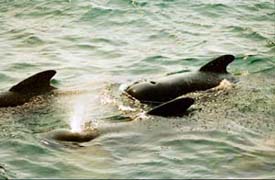
Globicephala melas
From the Latin, globus, for “globe” or “ball” and the Greek, kephale, for “head”; from the Greek melanus for “black”.
Length: Males, up to 20 feet. Females up to 18 feet.
Weight: Males, 3 tons. Females 2 to 2 ½ tons.
At Birth: Six ft. in length, and weighing 80 kg.